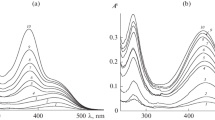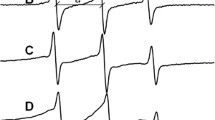Abstract
Three different spin-lattice relaxation times (T 1) of water were obtained in activated alumina-water slurry system, which indicate that there exist three states of water: bound water, pore water and bulk water. The chemical shift (δ H) decreases as the amount of water added to the system increases due to the differences in contribution of these three states of water in the samples. Theδ H value for adsorbed water decreases nearly linearly andT 1 increases with elevating temperature, which result from the decrease in the content of bound water by the increase in thermal motion.
Similar content being viewed by others
References
Rados N, Al-Dahhan M H, Dudukovic M P. Modeling of the Fischer-Tropsch Synthesis in Slurry Bubble Column Reactors.Catal Today, 2003,79–80: 211–218.
Swart J W A, Krishna R. Simulation of the Transient and Steady State Behavior of a Bubble Column Slurry Reactor for Fischer-Tropsch Synthesis.Chem Eng Process, 2002,41: 35–42.
Hartland S, Mecklenburgh J C. A Comparison of Differential and Stagewise Counter Current Extraction with Back-Mixing.Chem Eng Sci, 1966,21: 1209–1225.
Gaikwad A G, Sansare S D, Choudhary V R. Direct Oxidation of Hydrogen to Hydrogen Peroxide over Pd-Containing Fluorinated or Sulfated Al2O3, ZrO2, CeO2, ThO2, Y2O3 and Ga2O3 Catalysts in Stirred Slurry Reactor at Ambient Conditions.Journal of Molecular Catalysis A: Chemical, 2002,181: 143–149.
Benham M J, Cook J C, Li J-C,et al. Small-Angle Neutron Scattering Study of Adsorbed Water in Porous Vycor Glass: Supercooling Phase Transition and Interfacial Structure.Phys Rev B, 1989,39: 633–636.
Bellissent-Funel M C. Water near Hydrophilic.J Molecular Liquids, 2002,96–97: 287–304.
Xue X, Kanzaki M.Ab initio Calculation of the17O and1H NMR Parameters for Various OH Groups: Implications to the Speciation and Dynamics of Dissolved Water in Silicate Glasses.J Phys Chem B, 2001,105: 3422–3434.
Kohn S C. The Dissolution Mechanisms of Water in Silicate Melts: a Synthesis of Recent Data.Miner Mag, 2000,64: 389–408.
Gunko V M, Turov V V. Structure of Hydrogen Bonds and1H NMR Spectra of Water at the Interface of Oxides.Langmuir 1999,15: 6405–6415.
Vold R L, Waugh J S, Klein M P,et al. Measurement of Spin Relaxation in Complex System.J Chem Phys, 1968,48: 3831–2832.
Freeman R, Hill H D W. High-Resolution Studies of Nuclear Spin-Lattice Relaxation.J Chem Phys, 1969,51: 3140–3141.
Ning Yong-cheng.The Spectroscopic Identi fication of Organic Compounds Beijing: Science Press, 2002. 127–129 (Ch).
Peri J B. Infrared and Gravimetric Study of the Surface Hydration of γ-Alumina.J Phys Chem, 1965,69(1): 211–219.
Hampson J W, Bleam W F. Thermoanalytical Studies of Water on Activated Alumina, Brockmann 1–5, (Acid, Neutral, Basic) from −60 °C to +700 °C.Thermochim Acta, 1996,288: 179–189.
Qiu Zu-wen, Pei Feng-kui.Nuclear Magnetic Resonance Spectroscopy. Beijing: Science Press 1992. 251–257 (Ch).
Author information
Authors and Affiliations
Corresponding author
Additional information
Foundation item: Supported by the National Natural Science Foundation of China (20171035)
Biography: ZHOU Rui (1977-), female, Master, research direction: surface chemistry.
Rights and permissions
About this article
Cite this article
Rui, Z., Yan, Z., Kai, H. et al. NMR revealed activated alumina-water interaction. Wuhan Univ. J. Nat. Sci. 10, 572–576 (2005). https://doi.org/10.1007/BF02831148
Received:
Issue Date:
DOI: https://doi.org/10.1007/BF02831148




